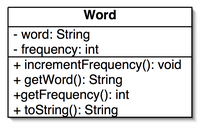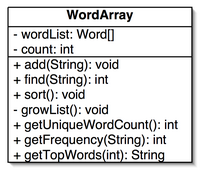Word. Here is the UML diagram for Word:

String) and the frequency (int) as private
member variables. The constructor initializes the word to an initial String value,
passed as a parameter, and the incrementFrequency- takes no parameters, increments the word frequency by 1, and returns nothing.getWord- takes no parameters but returns the actual word as aString.getFrequency- takes no parameters but returns the value of frequency as anint.toString- returns a String which is the concatenation of a word and its frequency, with space or prose in between (e.g., "foo occurs 10 times").
No other accessor methods are needed for this assignment.
WordArray. You should implement WordArray; it has the following UML diagram:

wordList is your array of words. (Use the array syntax we discussed in class;
do not use an ArrayList object!) Your list should have the capacity to store 1000 words initially.
count
is an int that will keep track of how many (unique) words are in your wordList
(and will tell you where to put the next word). You should
initialize these appropriately in your default constructor (which will take
no parameters). Finally, you should write the following methods.
- (1 point)
find- should implement linear search over the words in yourwordList. It takes a word (String) to search for and returns the index of the word if it is in the list. If it's not in the list, return -1. Note: You should ignore case when checking to see if a word is in your list, i.e., "The", "the" and "tHe" all the same word. - (1 point)
add- should take a word (as a String) and add it to yourwordListarray. If the word is already in the array, you should not add it again; instead, increase the frequency of the word by one. Also, be sure to check that there is space in the array for any new items before adding a word. If not, call the local methodgrowList(see below) to increase the size of the array for you. - (1 point)
growList- should double the size of your array. Recall that arrays (as we covered) cannot be resized. So, to grow the list, you should create a new array that is twice the size of the current list, copy all the elements fromwordListto this temporary array, and then replace thewordListreference with this new list. - (1 point)
sort- should sort the list by word frequency in ascending order. You should implement the bubble sort algorithm to perform the sort, leaving you with a sorted array. You should implement this using the Java covered thus far in class. Do not use Comparable classes or built-in Java sorting mechanisms. If in doubt, consult an instructor or TA. - (1 point)
getUniqueWordCount- return the number of unique words in your list. - (1 point)
getFrequency- takes aStringand returns either the frequency of the word, if found, or a -1 if not found. - (1 point)
getTopWords- takes an int (i.e.,n) and, assuming someone has sorted the list first, returns a String containing the n most frequent words with their frequency. Hint: you can put "\n" characters into the String to allowWordBankto nicely print more than one word's results (i.e., on multiple lines) on the screen.
WordBank driver class. WordBank should
first take a filename as a command-line parameter, create a Scanner
for the file, and read all the words from the file one word at-a-time, adding each to your local
WordArray. (3 points)Recall the default
Scanner breaks tokens (via the next()
method call) based on whitespace, and will not ignore punctuation
in the file. However, the Scanner for your file can be customized to consider non-word
characters (where word characters are defined to be a-z, A-Z and 0-9) as
delimeters in addition to whitespace, thereby effectively ignoring punctuation.
To do this, use the following code to create your file scanner:
Scanner fileScan = new Scanner(new File(filename));
fileScan.useDelimiter("[\\s\\W]+");
filename is the text name of the file you want to open. (This method for changing
the delimiter is non-optimal as it breaks hyphenated words, possessive quantifiers, etc.
Can you think of a better way to do it? One point of extra credit if
you can correctly handle words with hyphens and apostrophes.)Once you have read all the words in the file,
sort them (so
that getTopWords will work). Next, use WordArray's
getUniqueWordCount
to print out the total number of unique words, create
a new Scanner for user input, and repeatedly prompt the
user until they hit enter at an empty prompt to quit the program.
$ java WordBank test.txt
test.txt has 865 unique words.
Enter a word to get its frequency, a number to
list the top N words, or a blank line to quit.
> a
Word a occurs 50 times.
> 10
the with frequency 191
I with frequency 97
to with frequency 74
and with frequency 71
of with frequency 64
a with frequency 50
my with frequency 43
in with frequency 41
was with frequency 40
her with frequency 35
> (user just hits Enter)
$
For full credit, you should handle both the ability to search for words (2 points) and the top N words (2 points) by calling the appropriate method in the
WordArray and printing out the returned result. If
the user enters a word that doesn't exist or enters a value of N less than
1, print an error. Apart from these two scenarios, you can assume
"valid" input. Hint: java.lang's Character class has a few utility methods that
help you determine if a character is a number or a letter; you can grab the
first character of the String containing a line of user input, use these methods to decide
what kind of input the user has made, and then process them accordingly.By the way, if you want sample ASCII files to test your code, check out Project Gutenberg -- you can play around with classic literature of various shapes and sizes. Here's Machiavelli's The Prince, for example. Note that some of the larger files may be quite slow, so we encourage you to first test your code against a small sample text file of your own (or Google for one).